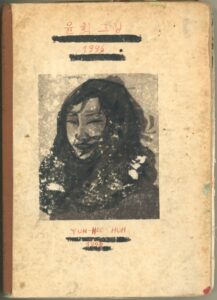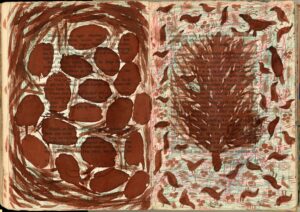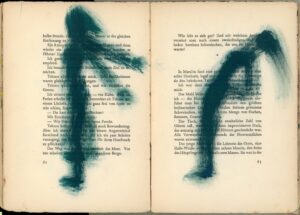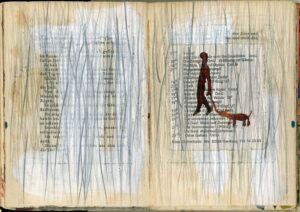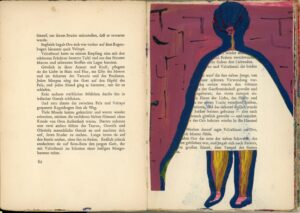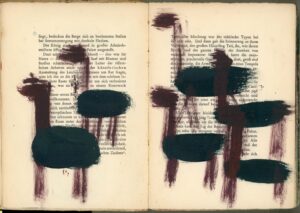윤희그림
세상에 하나뿐인 책, <윤희 그림>에 대하여
독일로 떠났다. 1995년 4월, 나는 미술 공부를 하기 위해서 유학길에 올랐다. 처음 도착한 도시는 하이델베르크였다. 막스베버하우스에서 1년간 독일어를 배웠다. 오전 9시부터 12시까지 독일어 수업을 하고, 오후에는 기숙사로 돌아와서 그림을 그렸다. 독일 미술대학교의 입학시험에 낼 그림들을 준비하였다.
어느 날 독일어 수업을 마치고 기숙사로 돌아오는 길에 헌 책방을 발견하였다. 바닥에서 천장까지 사방이 온통 책으로 둘러싸여 있었다. 일층에는 인문학과 자연 과학 분야의 책이 있었고, 이층에는 예술분야의 책들이 있었는데 특히 이 층에는 독특하고 근사한 책들이 많았다. 나는 틈이 나면 그곳에 가서 책을 보며 시간을 보냈다. 오래된 책들에게서 나는 은은한 시간의 냄새를 맡으며 미지의 세계로 나래를 펴곤 했다.
어느 날 책 한권이 눈에 들어왔다. ‘NOA NOA’라는 제목의 책이었다. 표지에는 고갱이 그린 타이티 여인의 얼굴이 실려 있었다. 노아노아는 폴 고갱이 타이티에서 살았던 실화를 배경으로 쓰여진 소설이라는 것은 대충 알고 있었지만 실제로 읽어보지는 못했었다.
책을 펼쳐 보았다. 금속 활자 인쇄가 된 오래된 독일어 책이었다. 책을 넘기다가 책갈피에 끼워둔 빛바랜 독일 신문을 발견하였다. 조심스레 펼쳐보니 고갱의 전시회에 관한 신문 기사였는데 타히티여인을 그린 드로잉이 실려 있었다. 그 책을 갖고 있던 사람이 고갱의 전시회에 관한 신문 기사를 오려 책갈피에 고이 끼워 둔 것이었으리라. 누군가의 추억을 간직하고 있는 그 책이 더욱 특별하게 느껴졌다. 고갱은 자유와 예술을 찾아 타히티로 떠났고, 나도 자유와 예술을 꿈꾸며 독일로 떠나 왔다. 고갱과 나의 처지가 비슷하다고 생각되었다. 그 책을 사서 가슴에 품고 기숙사로 돌아왔다.
두꺼운 종이에 금속 활자로 깊이 인쇄되어 있는 독일어 글씨는 손가락의 촉각만으로도 읽을 수 있을 것 같았다. 그러나 나는 그 책을 읽을 수 없었다. 초급 독일어 실력으로 그 책을 읽기에는 너무 어려웠다. 독일어 글씨는 나에게 풀지 못하는 비밀스런 기호였다. 길거리에서 들리는 독일 말도 나에게는 알 수 없는 소리에 불과했다. 그 세계에 들어가고 싶고 이해하고 싶었지만 그 곳으로 들어가는 문은 쉽게 열리지 않았다. 나는 고독한 이방인이었다.
책을 앞에 두고 며칠을 고민했다. 나는 나의 상황을 받아들이고, 그 상황에서 내가 할 수 있는 것을 하기로 마음먹었다. 책을 펴고 붓을 들었다. 그 위에 그림을 그리기 시작했다. 낯선 곳이지만 나는 여기서 뿌리를 내리고 살아야 한다. 이곳을 배경으로 나의 삶의 이야기를 만들어 나가야 한다. 독일어는 그림의 배경이 되고 그 위에 나의 이야기를 그려 나갔다. ‘이 곳에서 과연 내가 설 자리가 있을까?’ 외롭고 불안한 마음과 동시에 그립고 사랑하는 것들을 그렸다.
어느새 책 한 권이 그림으로 모두 채워졌을 때 나는 ‘노아 노아’란 제목을 지우고 ‘윤희 그림’이란 제목을 썼다. 타히티 여인의 얼굴 위에 미소 짓는 내 얼굴을 슬쩍 덧그렸다. 나는 이 책을 독일 미술대학교 입학시험에 냈다. 그리고 당당히 합격했다. 교수님들과 학생들이 이 책 작품을 보고 칭찬해 주었다. 책의 이야기와 그림이 아주 잘 어울린다고! 얼마나 여러 번 읽은 거냐고!
독일이라는 미지의 세계에 첫 발을 내디디며 막막하고 외로울 때 나는 그 책 위에 그림을 그리며 터널 같은 시간을 통과하였다. 타히티에서 고갱이 마주했을 고독을 생각하면 나의 고독도 외롭지 않았다. 그 책으로부터 따뜻한 위안을 받고 힘을 얻었다.
이십년이 지난 지금 그 책을 펼치면 독일의 작은 기숙사 방에서 그림을 그리던 나의 스무 살 시절이 떠오른다. 그 책은 나에게 나지막이 속삭인다. 어떤 상황에서도 외로워 하지 말라고, 너의 길을 찾으라고, 너는 이 세계의 중심이라고.
On Yun-hee’s Drawings, a One-of-a-Kind Book
I left for Germany in April 1995 to study art. The first city I arrived in was Heidelberg. I studied German for a year at Max Weber Haus. From nine in the morning until noon, I attended German classes. In the afternoons, I would return to my dormitory and draw. I was preparing a portfolio to submit for the entrance exam to a German art university.
One day, on my way back to the dormitory after German class, I stumbled upon a secondhand bookstore. From floor to ceiling, the space was completely surrounded by books. The first floor held volumes on the humanities and natural sciences, while the second was devoted to art. That upper floor, in particular, housed an array of unique and remarkable books. Whenever I had the chance, I would go there and spend time immersed in them. Surrounded by these old books, I would breathe in the subtle scent of time and let my mind take flight into unknown worlds.
A particular book caught my eye. It was titled NOA NOA. On the cover was the face of a Tahitian woman painted by Gauguin. I had a vague idea that NOA NOA was a novel based on Paul Gauguin’s real-life experiences in Tahiti, but I had never actually read it.
I opened the book. It was an old German volume printed with metal type. As I flipped through its pages, I came across a faded German newspaper tucked inside as a bookmark. Carefully unfolding it, I found a newspaper article about a Gauguin exhibition, featuring a drawing of a Tahitian woman. It must have been that the book’s former owner had carefully clipped the article and placed it between the pages. The book, carrying traces of someone’s memory, felt all the more special to me.
Gauguin left for Tahiti in search of freedom and art, and I, too, came to Germany dreaming of freedom and art. Our paths felt alike. I bought that book, held it to my chest, and returned to my dormitory.
The German text, deeply pressed into the thick paper with metal type, felt as though it could be read with the fingertips alone. But I couldn’t read the book. My beginner-level German wasn’t enough—it was too difficult. The German script was an uncracked, mysterious code. Even the German spoken on the street sounded like unintelligible noise to me. I yearned to enter and comprehend that world, yet the gateway remained stubbornly closed. I was a solitary outsider.
Days passed as I contemplated the book. I resolved to embrace my circumstances and do what was within my power. I opened the book, took my brush, and started painting directly onto its pages.
Despite being a stranger here, I had to put down roots and make a life. I needed to build my life’s story with this land as its foundation. The German text became my canvas upon which I painted my stories. ‘Will I truly find my standing here?’ I painted feelings of loneliness and anxiety along with the things I missed and loved.
Before I knew it, I had filled the entire book with drawings. I erased the title NOA NOA and wrote Yun-hee’s Drawings in its place. Over the face of the Tahitian woman, I gently painted my own smiling face. I submitted the book as part of my application to a German art university and was proudly accepted. Both professors and students praised the work, noting how well the story and paintings complemented each other! They even asked me how many times I had read the book!
When I first stepped into the unknown world of Germany, feeling lost and lonely, I navigated through that tunnel-like period by drawing on that book. Thinking of the solitude Gauguin must have faced in Tahiti made my own didn’t seem so heavy. That book offered me profound solace and renewed my spirit.
Now, two decades on, when I open that very book, I’m vividly reminded of my twenties, drawing in a humble dorm room in Germany. The book murmurs quietly to me: Don’t be lonely whatever happens; find your own path, for you are the center of this world.
